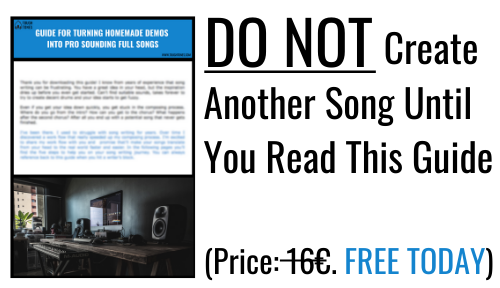How to Know When the Mix Is Done?
There’s a lot of talk about starting the mixing process and the different phases of it. So many guidelines and instructions are all over the internet. Sometimes you get so lost in the mixing process that in some point you start to over-do it. From that point on, you’re doing more harm than good. It’s obvious you don’t want to ruin all the hard work you’ve been doing. That raises the question: How do you know when it’s time to wrap things up and move on? How to know when the mix is done and finished?
The main idea of mixing is to present the tracks to the audience in as good light as possible, right? You want your song to touch and move people. You want it to connect with the listeners. For that to happen though, you want to clear the mix from everything that distracts you or the listeners. Here are a few ways to do that:
Nag list
Use a tool I call ”The Nag List”. Here’s how it works: Listen the song through without looking at the screen at all. Grab a pen and paper and make a list what’s still bugging you in the mix. The point is to write all the things down instead of tweaking them at the moment you hear them. Focus. Close your eyes and listen through the whole song. Don’t pause, simply write down what needs to be done and continue listening.
It could be an instrument that’s too loud or quiet in various parts of the song. A lead guitar is a bit too loud in a chorus. It could be a harsh frequency sticking out. The loudest vocal parts seem to have some annoying frequencies pushing through. It could even be a dull moment in the song. When proceeding from the intro to the verse, something’s not working. It’s lacking something. Look for these kinds of clues and write them down. They’re screaming to be fixed.

Listen with different speakers
Listen with a different pair of speakers before making the changes. Listen in different spaces with different systems. As you’re listening the song with several systems and you’re not making the changes right away, it prevents you from making rash decisions. After listening, make the changes and repeat the process. Is there still something that’s nagging? Look for more clues.
Reference to a commercial mix
When there’s no more clues to be found, reference your mix to a commercial pro mix. This time compare the overall tonality and balance. Change from a pro mix to your mix and back while playpack’s on. Remember to listen to both of the mixes with the same level, so you’re not fooled by the volume difference. Listen again with different systems and in different spaces. Write down what’s bothering you.
Do your song have way more bass than the pro mix? Are the drums starting to feel a little loud in your mix? Remember that your mix and the pro mix are different and your mix shouldn’t be the exact copy of the commercial mix, but you get to the ballpark by comparing them. Make subtle changes and repeat the process. If you start feeling like you need to do really big changes – take a break – it might be a good idea to sleep on it.
This sort of workflow of listing and fixing slowly takes your mix closer to the finish line. When you feel like there’s no more adjustments to be done, take a final listen. The final indication that the mix is finished is somewhat non-technical.
Hear the song instead of individual tracks
When you start hearing the song instead of the mix, you know you’re very close. You start feeling the song. Maybe you start even singing or jamming while banging your head to the beat. It’s hard to be objective when it comes to your own work, you question every decision and mixing move you make. In the end, the whole point is to deliver a great song to the listeners, not a great mix. It’s hard to put yourself in the position of a fan, who wouldn’t listen as critically. Keep in mind, that when you don’t acknowledge the technical stuff anymore, the listeners won’t either.
After all, music is an art, not science. Everything’s subjective. Something sounds good to one and bad to the other. There’s not one and only way to mix or to know when the mix is finished. There are some technical things to consider, and ways to make sure you’re on the right path, but they won’t tell you that you’re finished. Probably the best advice is that when you hear the song as a whole, and not just a bunch of individual tracks, you’re done.
Leave a comment below: Have you ever overmixed your songs? How do you know when your mixes are ready? Before I forget, download my free guide 5 Steps to Create Music Faster to avoid the writer’s block and get more music done in less time.
Tip: If you liked this post, you should check out also these articles: “How to Set Up a Project for Mixing?” and “Mixing Step Number One – The Raw Balance”
